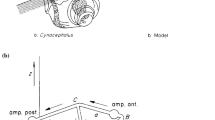Summary
The duct system of the nasal salt gland of the duck comprises central canals, secondary ducts and main ducts. The secondary and main ducts consist of a layer of columnar cells overlying a layer of small cuboidal cells. The columnar cells have complex intercellular spaces showing evidence of Na+ K+ -ATPase at the apical regions. Approximately 70% of surface area of the duct system is external to the gland. During adaptation to salt water the duct system increases in size as does the gland. Although the components of the gland of adapted ducks, including the duct system within the gland, increase in size compared with normal ducks, the percentage volume densities of the components remain similar in both categories of ducks, i.e. the duct system increases in size in proportion to the glandular tissue. The volume of the duct system external to the gland is six to seven times larger than the volume within the gland. Thus, if ductal modification of secreted fluid occurs, it will be most likely to take place in the ducts external to the gland.
Total surface areas of the duct system were measured from serial sections of glands and ducts from one normal and one adapted duck. These were used to calculate possible flux rates of water and sodium across the duct epithelium, assuming the occurrence of either water reabsorption or sodium secretion. Although these flux rates are high it is shown that they are similar to calculated flux rates across the luminal surface of the secretory tubules.
Similar content being viewed by others
References
Cereijido M, Rotunno CA (1968) Fluxes and distribution of sodium in frog skin. J Gen Physiol 51:280–289
Cornelisse JTWA, van den Berg TJTP (1984) Profile boundary length can be overestimated by as much as 41% when using a digitizer tablet. J Microsc 136:341–344
Ernst SA (1972a) Transport adenosine triphosphatase cytochemistry. I. Biochemical characterization of a cytochemical medium for the ultrastructural localization of ouabain-sensitive, potassium-dependent phosphatase activity in the avain salt gland. J Histochem Cytochem 20:13–22
Ernst SA (1972b) Transport adenosine triphosphatase cytochemistry. II. Cytochemical localization of ouabain-sensitive, potassium-dependent phosphatase activity in the secretory epithelium of the avian salt gland. J Histochem Cytochem 20:23–38
Fletcher GL, Stainer IM, Holmes WN (1967) Sequential changes in adenosinetriphosphatase activity and the electrolyte secretory capacity of the nasal glands of the duck (Anas platyrhynchos) during the period of adaptation to hypertonic saline. J Exp Biol 47:375–391
Gupta BL (1984) Models of salt and water flow across epithelia: an evaluation by electron probe x-ray microanalysis. In: Pequeux A, Gilles R, Bolis L (eds) Osmoregulation in estuarine and marine animals. Springer, Berlin Heidelberg New York, pp 191–211
Gupta BL, Hall TA (1981) Microprobe analysis of fluid-transporting epithelia: evidence for local osmosis and solute recycling. In: Ussing HH, Bindslev N, Lassen NA, Sten-Knudsen O (eds) Water transport across epithelia. Munksgaard, Copenhagen (Alfred Benzon Symposium 15, pp 17–35)
Holmes WN, Phillips JG (1985) The avian salt gland. Biol Rev 60:213–256
Karnovsky MJ (1965) A formaldehyde-glutaraldehyde fixative of high osmolarity for use in electron microscopy. J Cell Biol 27:137A
Kaye GI, Wheeler HO, Whitlock RT, Lane N (1966) Fluid transport in the rabbit gall bladder. A combined physiological and electron microscopic study. J Cell Biol 30:237–268
Kelley RO, Dekker RAF, Bluemink JG (1975) Thiocarbohydrazide-mediated osmium binding: a technique for protecting soft biological specimens in the scanning electron microscope. In: Hayat MA (ed) Principles and techniques of scanning electron microscopy. Vol 4. Van Nostrand Reinhold, New York, pp 34–44
Keynes RD (1969) From frog skin to sheep rumen: a survey of transport of salts and water across multicellular structures. Q Rev Biophys 2:177–281
Kirschner LB (1977) The sodium chloride excreting cells in marine vertebrates. In: Gupta BL, Moreton RB, Oschman JL, Wall BJ (eds) Transport of ions and water in animals. Academic Press, London, pp 427–452
Komnick H (1964) Elektronenmikroskopische Untersuchungen zur funktionellen Morphologie des lonentransportes in der Salzdruse von Larus argentatus. Protoplasma 58:96–127
van Lennep EW, Young YA (1979) Salt glands. In: Giebisch G (ed) Transport organs. Springer, Berlin Heidelberg New York (Membrane transport in biology. Vol 4B, pp 675–692)
Marples BJ (1932) The structure and development of the nasal gland of birds. Proc Zool Soc Lond 1932, pp 829–844
Marshall AT, Hyatt AD, Phillips JG, Condron RJ (1985) Isoosmotic secretion in the avian nasal salt gland: x-ray microanalysis of luminal and intracellular ion distributions. J Comp Physiol B 156:213–227
Peaker M, Linzell JL (1975) Salt glands in birds. Cambridge University Press, Cambridge
Phillips JE (1977) Problems of water transport in insects. In: Jungreis AM, Hodges TK, Kleinzeller A, Schultz SG (eds) Water relations in membrane transport in plants and animals. Academic Press, New York San Francisco London, pp 333–353
Schmidt-Nielsen K (1960) The salt-secreting gland of marine birds. Circulation 21:955–966
Skadhauge E (1978) Electrolyte transport across the bird coprodeum: role in osmoregulation. In: Schmidt-Nielsen K, Bolis L, Maddrell SHP (eds) Comparative physiology: Water ions and fluid mechanics. Cambridge University Press, Cambridge, pp 195–205
Weibel ER, Kistler GS, Scherle WF (1966) Practical stereological methods for morphometric cytology. J Cell Biol 30:23–38
Williams MA (1977) Quantitative methods in biology. In: Glauert AM (ed) Practical methods in electron microscopy, Vol. 6. North-Holland, Amsterdam New York Oxford, pp 1–234
Author information
Authors and Affiliations
Rights and permissions
About this article
Cite this article
Marshall, A.T., King, P., Condron, R.J. et al. The duct system of the avian salt gland as a transporting epithelium: structure and morphometry in the duck Anas platyrhynchos . Cell Tissue Res. 249, 179–188 (1987). https://doi.org/10.1007/BF00215432
Accepted:
Issue Date:
DOI: https://doi.org/10.1007/BF00215432




